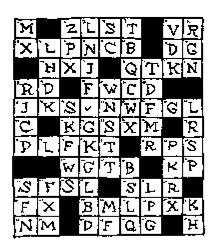The construction of a crossword consists of two operations that are quite different and in the end perfectly independent of each other: the first is the filling of the diagram; the second is the search for definitions.
The filling of the diagram is a tedious, meticulous, maniacal task, a sort of letter-based arithmetic where all that matters is that words have this or that length, and that their juxtapositions reveal groupings that are compatible with the perpendicular construction of other words; it is a system of primary constraints where the letter is omnipresent but language is absent.1 Contrariwise, the search for definitions is fluid, intangible work, a stroll in the land of words, intended to uncover, in the imprecise neighborhood that constitutes the definition of a word, the fragile and unique location where it will be simultaneously revealed and hidden. The two operations imply mental faculties that could almost seem contradictory: in the first, one proceeds by trial and error, starting over twenty or thirty times a grid that one always deems less than perfect; in the second, one favors intuition, fortuitous finds, sudden illumination; the first is done at one’s table, with obstinacy and tenacity, groping, counting, erasing; the other is rather done at any hour of day or night, without thinking about it, strolling, letting one’s attention float freely in the wake of the thousand and one associations evoked by this or that word. One can very well imagine—and one sees this sometimes—a crossword composed by two cruciverbalists, one of whom would supply the diagram, and the other the definitions.2 In any case, the two operations are almost always separate: one starts by constructing the diagram (generally starting from the first word across or down—which constitute what is called the gallows—chosen in advance because of a definition deemed felicitous), and it is once the diagram is completed that one starts to seek definitions of the other words it contains. Not only words, alas, but also groups of two, three, four letters, or even sometimes more, which, in spite of the author’s efforts, persist in not spontaneously offering any known meaning.
1. Of Diagrams and Black Squares
As opposed to the English-language tradition, where the positioning of the black squares matters more than their number, French cruciverbalists favor diagrams that include as few black squares as possible.3 The perfect diagram should thus contain no black squares: all the letters should cross and between them form words with meanings. The following examples aim to demonstrate the great difficulty of such perfect crossings. Admittedly, it is not really difficult to construct a 1 x 1 crossword with no black squares: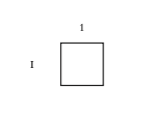
Across
I. Vowel
Down
1. Consonant
It is not much more challenging with a 2 x 2 crossword:
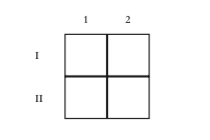
Across
I. Sloth.—II. Liner
Down
1. Like.—2. Exists
and barely harder with a 3 x 3 crossword:
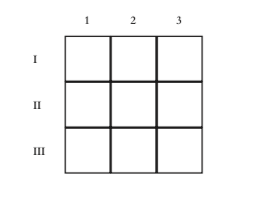
Across
I. It can fly, or hit one.—II. It may take trips.—III. Oh, baby!
Down
1. You do it around a track.—2. Before now.—3. Add up (or down)
Nor does a 4 x 4 diagram devoid of black squares present insoluble problems:
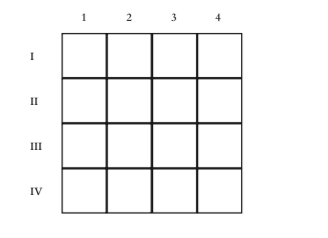
Across
I. Italian air.—II. It isn’t one.—III. Psychedelic rock.—IV. Bar with this tolerates no exceptions
Down
1. Flower in England.—2. Repurchase agreement.—3. Could it be that differences with its neighbor consist of a single letter?—4. Competent, even after taking off the cap
But if these first four diagrams can be made with almost no effort, it already takes a certain dose of patience to obtain a satisfactory 5 x 5 crossword:
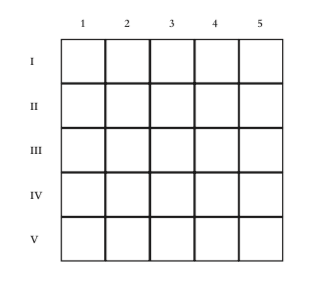
Across
I. Could be an archaeologist’s lucky break.—II. Definitely not a black and white situation.—III. Almodóvar’s friend.—IV. A picture that’s worth a number of words.—V. They’re often French in America
Down
1. Put it into your stomach, or put it around your neck.—2. Diamond circuit.—3. Some excuse!—4. His portrait could be in a gallery.—5. Foreign matter
As for a 6 x 6 crossword with no black squares, it can only be found at the cost of multiple attempts; the one below required many hours of work and the feverish, if not frenzied, consultation of a specialized dictionary:4
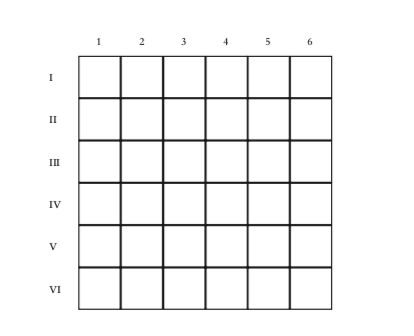
Across
I. Grape in Oman.—II. Niche.—III. Male organ.—IV. Their voices can be seductive or alarming.—V. Come out, come out.—VI. Adds some sauce
Down
1. Heavy crowds at church.—2. Love for Strangelove.—3. Panics.—4. Their future is bright.—5. Exact retribution.—6. Gets tight
Thus, the greater the area of the diagram, the more difficult it becomes to do without black squares.5 Obviously, one might have suspected it would be so. But I am always surprised to verify the degree to which this difficulty becomes greater and greater: up to a certain threshold, the construction of a diagram offers only average difficulties; beyond, it leads to nearly insurmountable obstacles. One can relatively easily compose a 9 x 9 diagram with six black squares; it is a little more difficult with five, extremely arduous with four, and nightmarish (or miraculous) to succeed with three; for a 10 x 10 diagram, it seems to me impossible to go below five; and for a 12 x 10 diagram, it seems so unlikely to succeed in getting it down to ten that when he finally managed this feat, Robert Scipion, the cruciverbalist of Le Nouvel Observateur, insisted on pointing it out to his readers, which is all the more understandable since he had been offering diagrams with eleven black squares for weeks and weeks, apparently with no major difficulties, and in any case without resorting to filler.6
Indeed, one cannot cross letters with impunity without creating barbaric groupings, and the solution to the diagram below illustrates well, it seems to me, the shortcomings attached to the illusory attempts to eliminate black squares. Sure, it is comforting to know that SSELYAR is RAYLESS in reverse7 and that PANDORE is another spelling for BANDORE (a renaissance guitar), but it is only at the cost of painful (and sometimes overindulgent) contortions that one will succeed in pretending to define things like TAA or ITD.
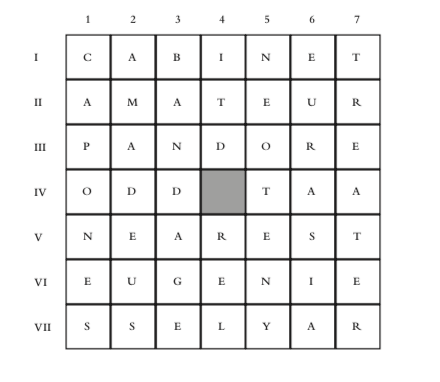
2. Attempt at a Definition of Definitions
Definitions like “River in Italy” (in two letters) and “All roads lead there” (in four) have always seemed to me to be absolutely opposed to the very spirit of crosswords. The first is a real definition (simply shortened, as compared with the dictionary definition); the second limits itself to citing the proverb from which the word one is seeking is extracted.
One could call these definitions first-degree definitions; they establish with the hidden word a simple equivalence:
River in Italy = PO
or replace implicitly the solution word by suspension points:
All roads lead to… = ROME
… we stand = UNITED
For the definition to start to function, there must be ambiguity. The simplest method, in a sense the second degree of the definition, consists in representing the word to be found (the signified) by a signifier that usually represents something else. Thus:
Bacon = MONEY
or better yet:
Used for spelling = INCANTATION
Or one will represent the signified by combining in the same definition two or three signifiers that are usually unconnected:
Refers to a nomadic Alabama sculptor three ways = MOBILE
Could be either dairy or meat = RABBIT
You need its room to apply its grease = ELBOW
Or else, one would find a way to enclose the definition within a semantic field very distant from that of the signified:
He deals with schooners and ports = BARMAN
One should not forget either what one might call metadefinitions, that is definitions making references within the vocabulary of crosswords itself. Thus, if the definition for IV across is
Should go the other way
the solution is presumably DOWN. For a III across defined by:
Is in its place
the answer is ACROSS (unless it is THREE). And even if it is far-fetched, it is more than plausible that a definition like:
Cross words
leads to INVECTIVE.
From there, countless variations are possible, including those one might call “homosyntactic,” which attach the definition to an element of the word being defined:
Has already started… = EROSIO
It is indeed missing a leg = ANPUTATED
What, in the end, characterizes a good crossword definition, is that its solution is obvious, as obvious as the problem had seemed insoluble as long as it was not solved. Once the solution is found, one realizes that it was very precisely stated in the very text of the definition, but one did not know how to see it, the whole problem being to see in another way: an eleven-letter word simply defined by “do” (it is, of course, a definition by Robert Scipion) drowned me for hours in an abyss of confusion until I realized that this “do” was half of “dodo,”8 and that the answer was demi-sommeil.9
It is not by chance that, in the ’30s, the constructor of the puzzle was known as Sphinx10 and the solver as Oedipus. The growing popularity of psychoanalysis has charged these terms with troubling connotations, but it remains true on the one hand that the riddle posed by the Sphinx was, if
I dare use this expression, blindingly simple, and on the other hand, that what is at stake, in crosswords as in psychoanalysis, is this sort of quavering of meaning, this “disturbing strangeness,” the uncanniness through which the language’s unconscious seeps out and reveals itself.
3. Of Filler
The only way to be forgiven the presence in a diagram of letter groupings that are scandalously deprived of meaning, or even strictly unpronounceable, is to find pleasant definitions for them. The standard example is “Head of state” for ST, or GH becoming “out of sight.”11
The second, third, fourth, and nth degrees apply, of course, to filler. Thus one can treat as filler words that are not: one can define GO as “Leave” or “Game” or “Goofy, at first” or “This ogling is looking on the internet.” When one tires of defining DO as “Note,” “Act,” or “Party,” there is no shortage of possibilities: “Starting to doubt,” “Inside of fedora,” “Connects Pan and Ra,” etc.
All variations on disorder, breakage, madness can serve to define jumbled words:
Sad and disturbed = ASD
Is actually a mess = SMES
For my part, I will never again hesitate to leave groupings like SVAE, VSEA, AEVS, etc. lying around my diagrams, being sure to define them very precisely like so:
Don’t touch, it’s broken!
As for reversals, they will obviously be under the protection of the good king Dagobert:12
Dagobert! = GNIK
Would wear his britches the right way = TREBOGAD
Well placed to advise Dagobert = IOLE
etc.
4. Of Novelty
The main shortcoming of beautiful definitions13 is that they can no longer be of service. Never again will one be able to write “Vide les baignoires et remplit les lavabos,”14 “Du vieux avec du neuf,”15 “Feu rouge,”16 or “Elle aimait trop le parmesan”;17 any other definition next to them appears prohibitively insipid and it is therefore nearly impossible to reuse the words ENTRACTE, NONAGENAIRE, STALINE, or SAN-SEVERINA.
There are many words in the language, and it will always be possible to find new ones for the gallows. But the problem is probably more difficult with the last horizontal and vertical words: given the constant search for words that offer a maximum of “final” letters (E, S, T, R, N, L, D), one ends up always landing on words like RESTLESS, SETTLERS, TENSENESS, TERSENESS, RELENTLESS, STRESSES, DESSERTS, ENDLESS, TRENDSETTER, RENDERED, and TENDERNESS, which one forbids oneself from defining twice in a row in the same way.
It is especially for “small words” and filler that the cruciverbalist must show cleverness: a certain number of words exist that, when all is said and done, only exist in crosswords; these are the famous ERS, ODA, RET, ANOA, ERI, and the like, and the cruciverbalist will make it a point of honor to find for them a new definition each time.
Thus an author once was able to write that no one could claim themselves to be a crossworder who was not ready to define the cow Io in 100 different ways. As for me, I’m only up to twenty-eight, but I have not given up on reaching this goal in the future:
Cowgirl
Have a cow!
The last we heard from MacDonald’s farm
Ex officio
Ab initio
Vowels
Lionheart
Coming back from Boise
By Jupiter!
Drops of iodine
The ultimate in audio
Piece of the action
Ionesco characters
Regional center
Opening of Iolanthe
It’s base
Violin duet
Trio members
Rational number
Idaho’s borders
A priori deduction
Most of debt
Eastern Ohio
She’s engaged in coition, either way
A couple of ravioli
Ninth and fifteenth Greek letters, or half of ninth
Was she cowed by Zeus?
Dior showing
One should note that some of these definitions do not apply at all to our heifer but only to the letters I and O.18
5. Of an Unsolvable Crossword
The formal definition of an unsolvable crossword is simple: it is a crossword in which one does not solve a single clue. Should it be possible to place with certainty even a single letter, one could through intersections, albeit at the price of endless trials, reconstitute the whole puzzle: definitions like “participle,” “possessive,” “article,” “direction,” “points,” “note,” etc. allow one to place a U, or an A, or an L, etc. Starting there, one can always find, for example, such and such a word of six letters with an A in third place, or a final N.
In practice, I do not think there are unsolvable crosswords, but only crosswords whose solution is made more difficult by the choice of little-known words. Though I myself prefer crosswords made of simple words, whose difficulty comes from confusing definitions, I offer you, to get done with this brief introduction, a crossword whose—let’s face it—commonplace definitions hide a certain number of rather rare words:
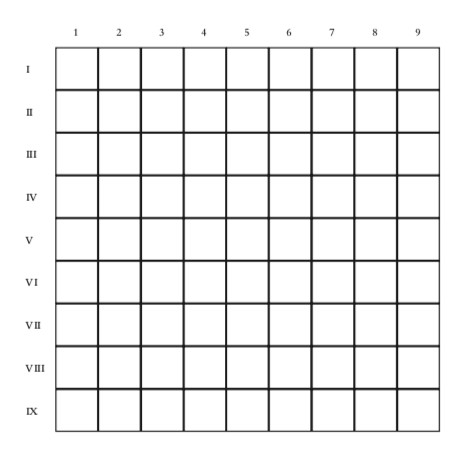
Across
I. You are here.—II. A dieter’s likelihood of success.—III. Spat.—Core of core.—IV. Rose to face—V. He can lead a harmonic.—Its act is intimidating.—VI. Change the handle of.—Method.—VII. Not quite ten.—Coiffure.—Managed.—VIII. She had a nice bust.—IX. Egg salad ingredients.—Salt.
Down
1. Brood.—2. Vestibules.—3. Common type.—4. Staff connections.—5. Gets punched out because of politics.—Merrier?—6. Removal, even if it were electronic.—Tabletop.—7. The far side of the moon.—It is related to the circumference.—It is the circumference.—8. Blind spots.—9. Constrictor.
6. Solutions
We will not insult the reader by giving him the solutions for the 1 x 1 and 2 x 2 diagrams. To respect the tiny feeling of frustration suffered by fans who are forced to wait until the next day or the next week for the solution of a crossword on which they struggled long, we will also not give the solution to the preceding puzzle.19
B A T
E G O
T O T
A R I A
V E R B
O P A L
N O N E
S H A R D
C O L O R
A M I G O
R E B U S
F R I E S
M U S C A T
A L C O V E
S T A M E N
S I R E N S
E M E R G E
S A S S E S
1. Upon rereading this sentence, I said to myself that it would perhaps be clearer if I gave an example. Starting with this randomly chosen word:
M I M O S A
there are obviously six possibilities for words, say of six letters, which start respectively with M, I, M, O, S, and A. But if under the word MIMOSA I write, say, the word REFUSE:
M I M O S A
R E F U S E
I instantly suppress four of those six possibilities, because there are no words (or so few) starting with MR, IE, MF, and SS, and I would only be able to construct down words starting with OU (OUTAGE, OUSTER, etc.) and AE (AEGEAN, AENEAS, etc.).
In contrast, if I choose a word like ABACUS:
M I M O S A
A B A C U S
the six groups thus formed remain capable of yielding down words, for example MArine, IBeria, MAting, OCular, SUperb, etc.
If I managed to repeat this operation successfully four more times, I would obtain a 6 x 6 diagram with no black squares. But no sooner do I select the third juxtaposition than the problem becomes much more taxing; a configuration such as:
M I M O S A
A B A C U S
S E X T E T
can yield something like:
M I M O S A
A B A C U S
S E X T E T
C R I A
O I M N
T A S E
But what would I do then with CRIA, OIMN, and TASE?
2. The translator of this article is a member of just such a team. Many crossword constructors, at least in the English language, now resort to computer software for diagram filling—a high-tech version of the division of labor envisioned by Perec. However, clue writing (at least the writing of the sort of clues he champions) remains the province of human constructors.
3. English-language-crossword constructors value symmetric diagrams and are concerned about the number of “unchecked” letters (letters that are not at the intersection of two words). If these concerns are addressed, the number of black squares does matter, and “wide open” diagrams are valued. In the end, differences in geometric constraints and in the available lexicon lead to different compromises. American crossword editors forbid unchecked letters altogether, require symmetry, and enforce a three-letter minimum word length. In spite of the enormous number and phenomenal variety of English words, this forces cruciverbalists to include so-called partials (phrases such as WASA, which might be clued as “It _____ dark and stormy night”). French constructors face different constraints, including a much smaller lexicon, and respond with different compromises, as described by Perec below. Having fewer words to work with must have made La Disparition (Perec’s e-less novel) much more daunting to write than its English translation (A Void, by Gilbert Adair).
4. Neither hours of work nor specialized dictionaries were needed for the creation of the English 6 x 6, probably because of the more varied structure of English words, and their abundance.
5. The introduction of the black square made the crossword possible. Grids with no black squares have existed much longer, in various shapes known to specialists as forms, but have only survived as a challenge for obsessive constructors and computer programmers. The National Puzzlers’ League website features record-size English-language forms (puzzlers.org/dokuwiki/doku.php?id= misc:formrecords). Perec himself coined a ten-letter word for inclusion in 53 Days, to legitimate its use by an Australian formist who needed it to complete a “ten-square” (a square ten-by-ten grid with no black squares). Italian puzzlers, who work with a smaller lexicon and greater structural constraints, are awed by the interlocking possibilities afforded by English words.
6. We suspect this feat (a 12 x 10 grid with only ten black squares) would be even harder for English-language constructors—perhaps due to lack of practice with this sort of challenge.
7. One more aesthetic difference: English-language puzzle constructors would never use a word spelled backward when conventional efforts at grid filling fail.
8. “Sleep,” in baby talk
9. “Half-sleep”
10. The Sphinx remains the symbol of the National Puzzlers’ League in the United States and of “classical” puzzlers in Italy.
11. Filler is forbidden in English-language crosswords. However, Perec’s approach to cluing them is reminiscent of cryptic crosswords. In a cryptic, clues address not only the meaning of the entry word but also its formal existence as a string of letters or sounds. Example: “City of New Orleans” is a clue for SALERNO, which is a city. As a string of letters, Salerno is a “new” ordering of the letters in “Orleans.”
12. A king of the Franks in the 600s, he is the protagonist in a children’s song, in which he has put on his trousers backward. Saint Eloi was his court advisor.
13. These classic clues would be extraordinarily difficult to translate faithfully, so we reluctantly decided to keep them in the original French and supply explanations for each one.
14. Apparent meaning: “Empties the bathtubs and fills the sinks.” Actual meaning: “Empties the loges and fills the bathrooms.” The solution is “intermission.” This clue is so famous it is attributed to more than one constructor, and is known by some people who have never solved a crossword (e.g., this translator’s mother).
15. Apparent meaning: “Something old with something new.” Actual meaning: “Someone old involving ‘nine.’” The solution is “nonagenarian.” This clue is mentioned in Life A User’s Manual.
16. Apparent meaning: “Red light.” Actual meaning: “Dead communist.” Solution: “Stalin.”
17. Apparent meaning: “She was too fond of parmesan (cheese).” Actual meaning: “She was too fond of a man from Parma.” San-Severina is a character in Stendhal’s La Chartreuse de Parme.
18. Or the number 10.
19. While Perec was glad to leave them dangling, the frustrated puzzle solver will find the solution to this puzzle in the next issue of the Believer, as well as on our website at believermag.com/crosswords. Translated by Henri Picciotto with Arthur Schulman
This article is Perec’s foreword to both his books of crosswords. (Les Mots Croisés and Les Mots Croisés II © P.O.L 2003, 1986. It is published here with the permission of the copyright holder.) In this translation we attempt to mirror Perec’s spirit and his puzzle constructor’s ethos by using examples in English whenever possible. Perec is well known as a major literary figure, but it should not be forgotten that he was a serious cruciverbalist. Most writings about him (even in French) do little more than mention this interest of his. This is perhaps because most of the literati who have written about Perec are not themselves interested in puzzles or knowledgeable about them. But Perec himself did not separate literature from puzzling. Puzzles, after all, provide the backbone of the main story in Life A User’s Manual. His selection of the passage on jigsaw puzzles to provide the opening to the novel is evidence enough of the importance Perec gave to this. That the piece can be read both as a perceptive comment on puzzle construction and as a manifesto as to what he was up to in writing his magnum opus only gives us more evidence of the intimate relationship between those two sides of Georges Perec the creator.

